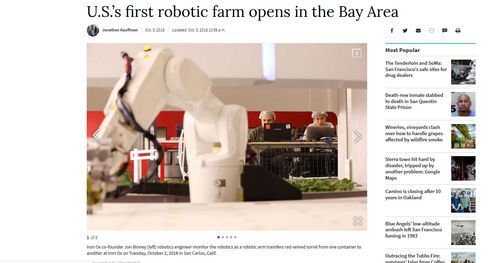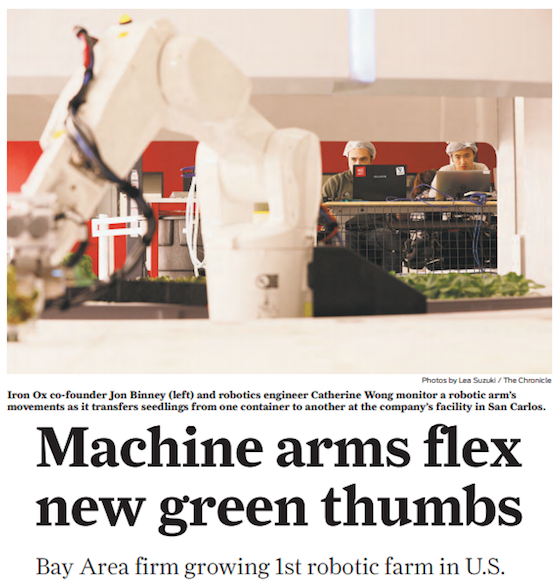
Automation: California Robotic Farm Shows Tech Is Changing Agriculture
10/07/2018
It’s pretty big news when a totally robotic farm opens up, and that’s what happened recently in the San Francisco Bay Area — San Carlos to be precise, just a few miles north of San Jose.
The story got front-page notice on the San Francisco Chronicle last week:

In the video below, company co-founder Brandon Alexander states, “We’re able to do the equivalent of 30 acres outdoor farming in just a single acre of our robotic farm.”
Certainly automation promises to make food production more efficient, if not quite the 30 to one improvement claimed here.
Still, when a third of California farmers say they “turning to automation” because of a shrinking labor supply, perhaps it’s time to think different about needing immigrant workers to do the picking because …
Automation makes immigration obsolete.
The need for labor is booming now because of Trump’s economy, but that situation will change when smart machines become cheaper than human workers.
U.S.’s first robotic farm opens in the Bay Area, San Francisco Chronicle, October 3, 2018
Angus doesn’t look like your normal farmer. He’s more of a giant, docile rectangle, built to lift 800-pound containers filled with water and seedlings and wheel them over to his partner robot, which looks like a giant arm with twin cameras set next to its gripping fingers.
It has taken a San Carlos company named Iron Ox three years to build these two core pieces of technology. As of Wednesday, they’re officially at work at the country’s first robotic farm.
Founders Brandon Alexander and Jon Binney met at the influential Silicon Valley robotics lab Willow Garage and quit their jobs in 2015 to dive into the farming world. “Let’s not build robots until we talk to a bunch of farmers,” Alexander said the pair decided. They road tripped all over California, asking farmers what their biggest point of concern was.
The answer was clear: labor scarcity.
According to a 2017 survey of 762 farmers conducted by the California Farm Bureau Federation, 55 percent of those polled reported labor shortages, and that figure was closer to 70 percent for those who relied on seasonal workers. Many had raised wages in an effort to attract laborers, but 33 percent of farmers said they were also turning to automation.
For California’s $54 billion agriculture industry, change is coming. “Labor-related tasks are kind of a big factor in what’s motivating farmers,” said David Slaughter, head of UC Davis’ Smart Farm Initiative. Many aspects of grain or cotton production have long been automated, but perishables — tree fruits, berries, lettuces — require the human touch.
Some robotics research is focused in the area of weeding and pruning, others on harvesting apples or strawberries. In the Salinas Valley, some field lettuce growers have adopted automation in the form of high-pressure “water knives” that move along the rows, cutting the bottoms of the heads and feeding them up to workers via conveyor belts, a process that eases the burden on workers’ backs.
Fully articulated robots like the ones operating at Iron Ox are rare.
“When it comes to automated, advanced mechanization, and specifically robotics, we’re very early in the game,” said Dennis Donohue, director of the Western Growers Center for Innovation and Technology, an agriculture-tech incubator program. (Continues)
